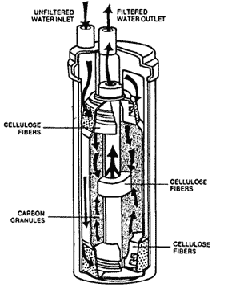For All Enquiries 1(775) 324 2400 - Sales 24/7 1(877) 540 4154
Espanol (Cesar Medina) 1(877) 540 4154
Introduction to Water Filters
Water filters are designed for specific types of contaminant.
This page gives a short introduction to all of the commonly used filters and also to some less common ones.
To find our about Ionlife USA-made specialty filters Please Click Here

Distillers
Distillation, according to John Archer's informative book on water, "The Water You Drink", is an ancient method where you heat water until it vaporizes. As the water vaporizes, bacteria, minerals and most other substances are left behind. The steam cools and condenses into relatively pure water.
Distilled water tastes flat because it has lost its dissolved oxygen.
The process is not effective against chemicals which have a boiling point below that of water. Volatile substances such as ammonia are carried over into the condensation chamber. This may include nasties such as Trihalomethanes, chloroform, trichloroethylene, and phenol. He recommends the addition of silver activated charcoal water filters.
Most distillers are slow, producing about 3 liters per hour. Stills have to be cleaned regularly and as boiling releases a lot of chlorine byproducts, it needs to be in an adequately ventilated area.
There have been a number of reviews of the distillation process including an infamous one by Dr. Zoltan P Rona.
There are four basic water filters :
- Distiller
- Reverse Osmosis Filters
- Activated Carbon Water Filters
- Backwash

REVERSE OSMOSIS

A technology that was originally designed to desalinated seawater, Reverse Osmosis Filters or RO are used widely to provide industry with purified water. It's a natural process adapted by technology which operates when two liquids of different concentrations are separated by a semi-permeable membrane. Water passes through the membrane towards the more concentrated solution. In home systems, this water is forced under pressure against an ultrafine semi-permeable membrane so fine as to allow only single molecules through, rejecting most contaminants. Unlike distillers, it allows oxygen to pass through, so RO water isn't dead tasting.
Typical units produce water drop by drop, so they need a pressurized tank to store the result for fast access. It's also rather inefficient in that it may take up to 5 liters of water to produce one clean liter. membranes must be replaced by a qualified tradesperson.

 ACTIVATED CARBON FILTERS
ACTIVATED CARBON FILTERS
Also called carbon filters, treat general taste and odor problems, including chlorine residue. When water flows through carbon filters, contaminants adsorb or stick to the surfaces of the carbon particles. Activated carbon filters are reported to be the best method available for removing specific organic chemicals, including some pesticide residues.
Studies have also shown that GAC (granular activated carbon) adsorption is an effective method for radon removal. Mechanical filters trap, through a straining process, sand, dirt, and other suspended particles to reduce turbidity in water.
Carbon water filter devices are available in several sizes and designs. Small units fit on kitchen taps. Large under-sink units, often called in-line filters, are designed to treat up to 1500 gallons. On such a unit the canister is connected to the cold water line. Other styles are available that treat all household water.
We include AlkaViva USA-made filters in all our ionizers for the cleanest and healthiest water. Our filters also allow beneficial soluble minerals to pass through the filter, into the ionizing chamber and out into the alkaline, ionized water. they are relatively inexpensive to replace and ensure a continued high standard of filtration.

Measure the NMR
Nuclear Magnetic Resonance (NMR) was developed in the fifties as a tool to investigate cellular pathology and may also be employed to measure molecular cluster size and the pH inside cells. The South Korean manufacturer of the water ionizer has recorded the following NMR measurements for the sizes of various water clusters. Hertz (Hz) measures cluster size. Lower Hz indicates less resistance of water into cells, therefore increased absorption.
|
Ionized Alkaline Water |
53Hz |
|
Naturally occurring Spa water |
80 Hz |
|
Village water (human longevity) |
80 Hz |
|
Mineral ground water |
94 Hz |
|
City water |
120Hz |

Measure the Electrical Charge (life force)
Measuring the frequency of the electrical charge around a substance in megahertz (MHz) is considered to be an indicator of vitality. Fresh organic produce and freshly ionized water has been found to exhibit a high level of vital energy whilst processed food and ordinary tap water have been found to have a low electrical charge and low frequency.
|
Food Item |
Average energy |
|
Canned foods |
0 MHz |
|
Chocolate cake |
2 MHz |
|
Kentucky chicken |
3 MHz |
|
Big Mac |
5 MHz |
|
Synthetic vitamin and mineral supplements |
20 MHz |
|
Ionized water |
60 MHz |
|
Fresh fruit |
67 MHz |
|
Green vegetables |
80 MHz |
Read about UltraWater Water Filtration Technology >>> Here

The statements enclosed herein have not been evaluated by the Food and Drug Administration. The products mentioned on this site are not intended to diagnose, treat, cure, or prevent any disease. Information and statements made are for education purposes and are not intended to replace the advice of your family doctor.


